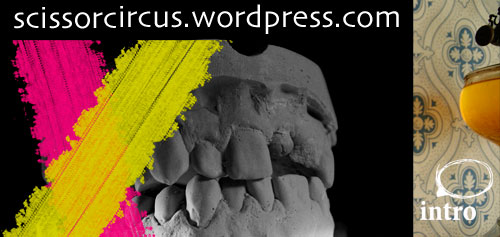
Large-hearted, fearless, quixotic, profoundly imaginative
P. Tepper’s personality is a painterly reflection of the inspirational figures he often quotes: Picasso, Madeleine L’Engle, Mark Ryden, and Dr. Seuss. Since moving to Ohio in 1997 he’s settled into what he calls a nondescript building tucked in the shadows of an American city. He and I were roommates in college. We’ve remained in touch at irregular intervals, the most recent of which when I caught up with him for this interview.
Daniel King: What’s your background?
P. Tepper: I grew up in Maryland, a small town in the mountains. Came to Columbus, Ohio to go to the Columbus College of Art and Design, and stayed here ever since. I’ve been living in a Carriage House in the Discovery District, downtown for the last 5 and a half years.
When I was 15 I wanted to do animation. I took a storyboarding class and hated it. At the same time, a friend of mine, Mariano Santillan, was studying painting and illustration. We would paint together. He was my biggest influence as a student. When you live life with someone, they can really influence you, as opposed to an artist’s work that I view in a book, or online. That’s a view from a distance. The living artists that inspire me are Mark Ryden, and Joe Soren. Van Gogh and Picasso are the big dead guys, I love them.
DK: Where does your imagery come from?
PT: I began a practice of drawing every single day. I’d scribble and sketch for an hour, spend an hour doing more structured drawing, and then an hour of color. I pick from these drawing for my painting ideas.

Image from Prayer series, P. Tepper 2009
DK: Are your paintings an attempt to express a pre-concieved idea? Or is the act of painting more open ended?
PT: Robert Henri believed that the goal isn’t to make art, but to live life. Art is evidence of a life lived. As far as walking up to an easel and beginning to paint, its more like dancing. There are certain steps you have to learn. As you learn the steps with your partner, you grow together.
No, I don’t start with a preconceived idea. Painting to me is like dancing with God. A collaborative process. There is that, often mentioned, invisible presence when making art. The best I can do is get out of the way.
DK: What is the idea behind this new series of paintings?
PT: The primary subject matter is the love between the man and the woman, and the problem is how to pull out the different aspects of that relationship. I try to represent it as fiery, passionate, and magical.
This new series I’m calling “variations on the theme of love”, represents Jesus and the church. Jesus is fierce, dangerous and powerful, but when he’s with his lover he doesn’t bruise or harm her. I’ve experienced God’s love. He can be loving and tender when I don’t deserve it. He’s big. I often use gold color to represent his presence within a painting.

Variations on the Theme of Love, P. Tepper 2009
DK: Instead of painting the series of images one after another in succession, your approaching them all at once. Like in the silkscreen process. Can you talk to me about the process?
PT: I am inspired by pop surrealism, artists like Mark Ryden, Joe Soren; these artists as well as (more recently) Andy Warhol, Shepard Fairey, and the printmaking process. Beginning with a single motif and expanding on it through a series of variations. Only I don’t do printmaking, I paint.
I complete step one and two all at once, lay down flat color and add the drawing across all 15 paintings. I then step out of that routine from this point forward. Usually if I paint something over and over again, it gets better and better each time. To avoid this I keep switching them around so that they’re all equally mediocre. (laughs)
Renoir painted light coming through leaves on a tree. There is a random fleck-i-ness which imitates nature. This is difficult to do. Even though all of my paintings are similar, I wanted them each to have a random pattern of light like leaves in a tree. Each similar yet different.
Also I don’t want to be a factory line worker, what I’d rather do is birth 15 children.
DK: All at once?
PT: Right.
DK: That’s painful…
So, this self imposed structure allows you to play with the painting process?
PT: Let’s say there’s a particular thing in one version that needs to be pulled out, highlighted, while the painting beside it cries out for attention to a different detail. They all may share common characteristics, but maintain their differences.
What I’m trying to work on is my versatility while focusing across 15 panels. I can work in an impasto approach in this one and use thin glazes in another. Keeping grounded within one common image allows me to focus on the act of painting without being distracted by subject matter.
DK: Your imagery seems to represent a spiritual expression for you. Why don’t we see more traditional iconographic (Judea-Christian) symbols, from art history, in your work?
PT: As far as traditional iconography of Christian artwork from history, I have no interest in repeating that. Someone once said that creativity may simply be the virtue of seeing that there’s no benefit to repeating what’s already been done. The classical images from the history of Christian art spoke to the generation in which they were made. I am speaking to my generation. I’m looking for innovative, provocative images. I like that I’m able to paint images of and about God. Just as the painters from history did for their culture. I’m carrying it forward.
I’m less influenced by popular culture. What I like about pop surrealism is not the pop references, but the fresh approach to surrealism. These artists aren’t repeating Salvador Dali.
DK: How do mythical creatures function in your work?
PT: I love CS Lewis. The Chronicles of Narnia uses mythical creatures to tell a relevant story. A great painting is a view of the invisible. A painters job is to pull the curtain back and to allow people to see this other world. I believe this other world is real.
Last year I was riding my bicycle around town a lot. I had these dinosaurs around me. They were flying, they had lasers and were breathing fire. They were my companions, I’d talk to them. It was so much fun! Like Dr. Seuss and CS Lewis used literature to pull the curtain back, I use painting to try to do the same thing.
DK: Do you keep a dream journal?
PT: I do, but my characters don’t come from my dreams. While I don’t dream about those creatures at night, I imagine them all day long. As I said, while I’m riding around on my bicycle I’m seeing dinosaurs and when walking through parks and gardens the trees are talking, having conversations. Even in my studio there are these ankle biters. Creatures are part of my waking hour.
Madeleine L’Engle talks about how culturally we have embraced pragmatic thought. If it doesn’t serve a purpose it’s not useful.
While I may not have health insurance, I do have imaginary creatures. We need that beauty.
DK: What keeps the fire going?
PT: Athlete’s careers and abilities peak when they’re young. When you look at artists’ careers, the peak traditionally comes much later, Picasso was in his 50’s when he painted Guernica. Artists, poets, philosophers take in observations of life and process it over a longer period of time. That’s something I keep in mind.
Van Gogh painted when no one wanted his paintings. While I wouldn’t mimic everything he did in life, I do hold on deeply to the fact that, no matter what, he was walking out into a field and painting, then going home and doing all over again the next day. Again and again. That’s the level of commitment painting requires.
I don’t try to fit painting into my schedule, but rather have scheduled my life around painting.
“Do whatever you do intensely.” — (Robert Henri)
DK: What kinds of practical solutions do you have to challenges in the studio? The road blocks…
PT: When painting 15 versions of an image, if one gets frustrating, I can put it aside and work on another for awhile. But when working on a single stand-alone image, it can be much more difficult to decide, is this working? Or should I just scrap it, and start over?
Working with acrylic, instead of oil, facilitates reworking in a much shorter time, if need be. On days when nothing is working, I might take a break from a larger project, to smear cheap paint on a board. Its fun and non-destructive, reminding me of what it was like to be a child with his father.
DK: Tell me about the Clown painting series.

image from the Clown Series, P. Tepper, 2009
PT: Through my drawings, I began adding eyes to make creatures out of scribbles. Once I had my invented characters, I began painting different versions, with a range of painting approaches.
DK: This image series has a loose playful energy, more so than the others. How do you know when a painting is finished?
PT: I’ve been reminded that the amount of time spent doesn’t make for a stronger finished painting. Picasso could, in 15 minutes, do a drawing that was beautiful. Van Gogh would finish a painting in an afternoon.
This allows me to stay loose when it’s right, and add detailed renderings too. Picasso was able to, in a few stokes, capture his idea. In terms of defining when it is done, I don’t know.
DK: Where do you see yourself in 10 years?
PT: I don’t believe I’ll win a million dollars, or hit it big and have the magical “I’ve made it” moment. There may be a parallel between climbing the corporate ladder, slow but sure, and the life of a working artist. My goal is to inspire people, the way I have been inspired by my favorite artists. And it would be nice to also sell enough work to make a living. I just want to contribute.
The past ten years I’ve been developing my skills as an artist. During the next ten I hope to begin effectively communicating the love of Jesus.
—
EXHIBITIONS
See P. Tepper’s work at The Grandview Hop this Saturday, on the walls of Hedman, Anglin, Bara across from Spagio. map
Sandbox Columbus co-working space at 853 Pearl Alley, stop in to see Paul’s work there as well through July.
On view at the Marcia Evans Gallery, map, throughout July and August 2009. He’ll be in the gallery during the July 4th and August 1st Gallery Hop nights.
CONNECT
twitter.com/ptepper
ptepper.com
Filed under: Art, Columbus, Interviews, CCAD, Columbus Ohio Painters, Discovery District, exhibitions, Grandview Hop, Joe Soren, Marcia Evans Gallery, Mark Ryden, OHintro, Paul Tepper, Pop Surrealism, PTepper, ptepper.com, Sandbox

